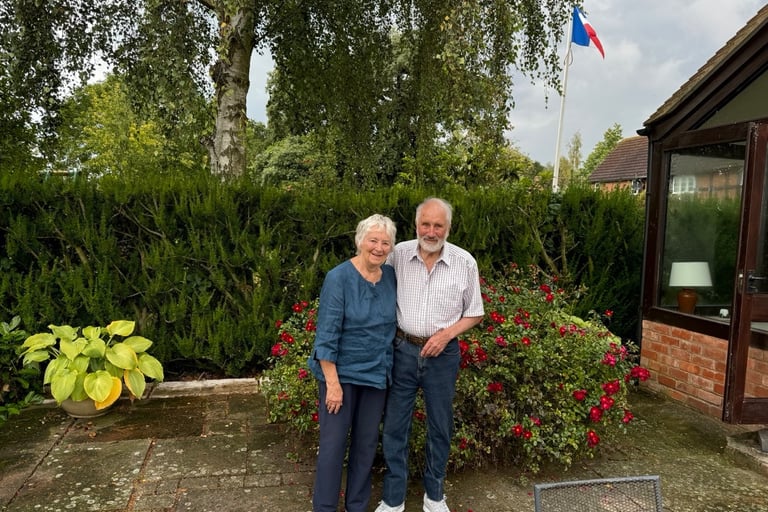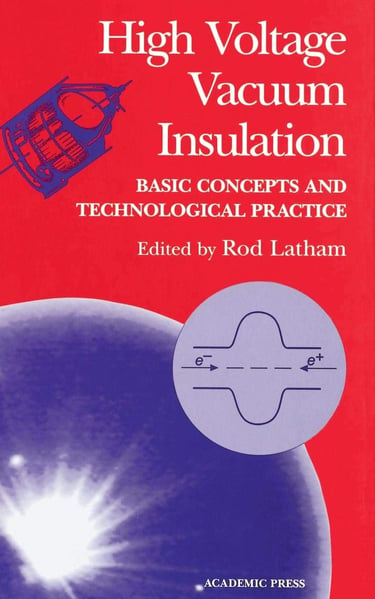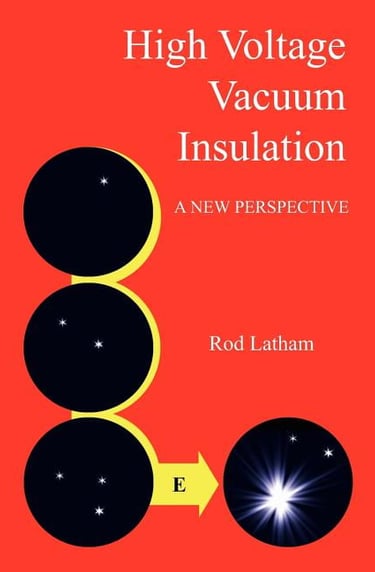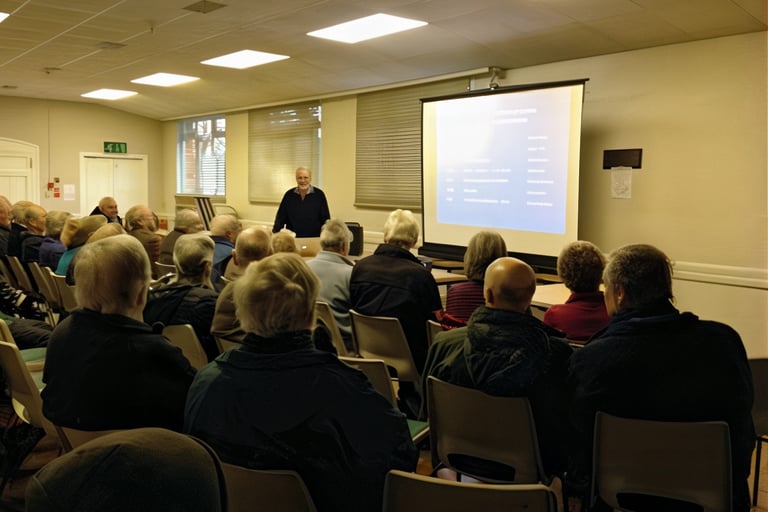Vacuum Insulation and Resilience: The Dual Legacy of Rod Latham
A tribute to the life and legacy of Rod Latham, a pioneering scientist in high-voltage vacuum insulation. Based on in-depth discussions during my visit to his home in September 2024, this article reflects on his groundbreaking work, personal journey, and lasting impact on the field.
3/16/202512 min read


In the world of high voltage and electrical insulation in vacuum, few figures have left as profound an impact as Rod Latham. With a career that spans six decades, Latham has witnessed—and contributed to—the evolution of a niche in high voltage studies in vacuum: the origin of pre- breakdown current.
In December 2022, I sent an email to Latham appreciating his contributions to the field including his book High Voltage Vacuum Insulation: Basic Concepts and Technological Practice which had become a companion of mine in dealing with high gradient phenomena [1]. Not only did he graciously respond to my initial messages, but he extended his time over several calls. By the time I visited him in Worcestershire, our conversations had grown beyond technical advice, revealing a remarkable life shaped by science, resilience, and curiosity.
On a trip to Cardiff to participate in the 2024 Universities Power Engineering Conference (UPEC), I seized the opportunity to visit Latham’s house, The Grainhouse, in rural Worcestershire to continue the discussions we had over video calls and emails—this time in person. Although Rod had recently been discharged after spending two weeks in the hospital, he and his wife, Jean, graciously opened their home for an in-depth conversation. Unsurprisingly, the in-person exchange was both more enjoyable and thorough. My six-hour visit turned out to be not just a technical discussion but a journey through the life of a man whose experiences have profoundly shaped his scientific perspective. We talked about everything from the challenges of vacuum breakdown to the ups and downs of Latham’s career and the philosophical questions about science and the human spirit that drive innovation. This article captures the essence of that dialogue, blending the technical with the personal, and the past with the future.
1 The Arduous Journey to a Career in Science
Rod Latham’s journey to becoming a disruptive figure in vacuum insulation is a story of resilience. Born three years before the beginning of World War II, Latham faced an uphill battle from the start. During the war, one in five schools in the United Kingdom was damaged by bombs. This impacted Latham as his education was disrupted. In addition, a severe childhood accident left him with lasting cognitive challenges. Later, he attended a modest school and, facing the challenges of self-studying to gain university entry. However, Latham’s passion for science never wavered. His academic journey was unconventional, and his early career marked by slow but steady progress. Yet, these adversities only fueled his determination to succeed.
He completed both his undergraduate and postgraduate studies at Queen Mary College, Uni- versity of London, earning his Bachelor of Science degree in 1958 and his Doctor of Philosophy in 1963. Later in 1984, the University of London awarded him the degree of Doctor of Science (In certain countries, like England, the Doctor of Science (DSc) is awarded at a more advanced stage in one’s career than the PhD, based on an extensive collection of published works and may include a comprehensive critique, honoring notable contributions to a particular discipline) for his contribution to the field of Surface Science. He worked his way up from a modest background, studying on his own to enter university.
Although his Ph.D. focused on ferroelectrics—a field unrelated to his later achievements—Latham’s entry into high voltage vacuum technology came almost by chance. While his supervisor explored whiskers for electron microscopy, Latham simultaneously worked on designing an electron probe us- ing the pyroelectric effect, sparking his first encounters with vacuum phenomena. Despite his early curiosity, he often felt like an outsider in the academic world, a sentiment reinforced during his first conference presentation on whiskers. He recalled an older gentleman candidly suggesting he was in the ’wrong field,’ a comment that lingered with him. Undeterred, Latham’s determination and adaptability propelled him forward. It wasn’t until his fifties that he earned a professorship—an achievement that stood as a testament to his perseverance and lifelong pursuit of knowledge.
2 Pre-breakdown Current: The Devil in the Details
The emission of electrons from high-gradient cathodes in vacuum was first observed in the late 19th century [2], with foundational theoretical descriptions later provided by Fowler and Nordheim in 1928 [3]. The field emission current arises from quantum tunneling, where high electrostatic fields reduce the potential barrier, allowing electrons to escape the surface. This emission current is sometimes called the pre-breakdown current in vacuum systems, a term used by scholars like Latham who study it as a precursor to vacuum breakdown. Some researchers, on the other hand, focus on its practical applications in X-ray tubes, scanning electron microscopes, and other electron- emitting devices.
For many, including myself, controlling field emission is crucial to preventing catastrophic electrical breakdowns. Latham’s insights into this area are as deep as they are nuanced, and occasionally controversial. The cold emission of electrons is traditionally attributed to the Fowler- Nordheim tunneling mechanism, at fields near 10⁹ V/m. On macroscopic levels, a high voltage design can fairly easily avoid gradients in this range. However, there is a strong evidence that there are , micro- and submicroscopic features that locally enhance the electric field to the 10⁹ V/m level.
While many strongly believe in the existence of metallic imperfections as the source of these features, Latham believes that non-conductive particulates could be the main source. His evidence has been based on the fact that mechanical polishing to the extreme extent has not be able to eliminate the sources of pre-breakdown current [4, 5]. Through dedicated diagnostic techniques, Latham discovered that electron emission in these setups often stems from microscopic impurity particles, frequently carbon-based, that adhere to or embed themselves within the electrode surface. This contamination initiates a semiconductor-like emission process, distinct from the quantum tunneling described by Fowler-Nordheim, making field emission highly sensitive to surface purity and materials used.
To tackle this, Latham proposes an alternative path for transformation: clean-room technology. He believes high-purity electrode materials aimed at minimizing impurities on electrode surfaces can increase the breakdown field achievable in large-area high voltage vacuum gaps. Notably, this shift revealed a hierarchy in electrode materials’ suitability, with titanium and tantalum proving superior in breakdown resistance, while copper and nickel have been found less effective.
Latham shared his insights on the practical visualization of this phenomenon, describing a setup where a voltage is gradually applied across a vacuum gap with a metal cathode and a glass anode coated in a luminescent film [6]. A high-speed camera records the sequence, capturing how electron emission initially appears at a localized “pre-breakdown” site. As the field increases, this site becomes unstable, culminating in a spark that triggers a cascade of new emission sites, thus degrading the vacuum gap’s insulating capability. This setup illustrates not only the origins of pre-breakdown current but also the inherent complexity in suppressing this process across large- area electrodes. A video recording of the aforementioned observation using the transparent anode method is available on Latham’s website [7].
3 Pivotal Events in a Remarkable Career
In the path toward becoming recognised in the field of high voltage vacuum insulation, it was essential for Latham to avoid being classed as an outsider, as was evident when he first spoke about his early research findings. Working his way up from a modest background, this sense of isolation, however, became a powerful motivator, driving him to overcome the challenges he faced, not just in his education, but in a field where competition was fierce and recognition often elusive. When I asked Latham about the critical moments in his career, he reflected on three pivotal ones that shaped both his work and his journey.
3.1 The First Book
One of the most pivotal moments in his career came when Latham was approached to write a book on his work. The offer from Academic Press to publish a book on his research came as a surprise to Latham, who was, in his words, “relatively unknown” at the time. He had been quietly working on his theories in vacuum breakdown at Aston University. “I was unknown, really,” he reflected. “Then one day, Academic Press reached out, asking if I’d write a book. It changed everything for me.” This publication introduced his work to a global audience, offering him a platform to showcase his ideas in vacuum insulation. For Rod, it wasn’t just an academic achievement—it was validation of his years of persistence and hard work to find a place in the field. He seized the opportunity and within a year, his first book, High Voltage Vacuum Insulation: The Physical Basis, was out.
3.2 CERN and Star Wars
CERN’s interest in Rod’s work was piqued by his theory on the dominance of dust in high voltage systems, especially after they encountered challenges achieving clean field emission through conventional methods like mechanical polishing. Recognizing that dust and microscopic debris could be significant factors in pre-breakdown currents, Latham's insights provided CERN with a fresh perspective on managing field emission inconsistencies. This collaboration not only underscored the importance of surface cleanliness for mitigating pre-breakdown current but also demonstrated influence fundamental research, even within large-scale projects like CERN’s. It was also a testament to how unconventional insights from outside the mainstream can often reveal overlooked aspects of complex problems.
In reflecting on his career, Latham also pointed to another turning point—his invitation to join the U.S. “Star Wars” initiative. This project brought him into collaboration with some of the leading minds at Los Alamos and Livermore National Laboratories, offering him a seat at the table in high-profile scientific discussions.
3.3 The Dyke Award
In 2010, it was nearly a decade since Latham had retired from his faculty position at Aston University and over two decades after he received the Whitehead Memorial Lecturer award for his contributions to high voltage vacuum insulation. Despite facing personal health challenges, Latham had remained as committed as ever to his research, publishing his third book, High Voltage Vacuum Insulation: A New Perspective. In an unexpected twist, just before he was scheduled for heart surgery, Latham received news of the Dyke Award—a distinguished honor for outstanding body of significant contributions in the field of electrical discharges or electrical insulation in vacuum. Reflecting on the moment, he remarked that it felt like a culmination of his lifelong work, particularly because the distance from the active engagements had grown a feeling of being forgotten. “I remember thinking,” he shared, “that this award was a testament not just to my work but to the resilience it took to get here.” The Dyke Award thus marked both a career milestone and a deeply personal achievement for Latham. His featured article for this award, once again re-iterated his scientific legacy: From “whiskers” to “dust” - the critical role of dedicated diagnostic techniques in promoting paradigm shift [8].
4 Outside the Vacuum
Rod Latham’s scientific career, deeply rooted in high voltage vacuum insulation, has always been accompanied by a broader fascination with the unknown. During our conversation, he shared an enduring interest in phenomena that challenge the conventional boundaries of science. “I’ve always been intrigued by ideas like telepathy,” he said, “where communication seems to happen beneath the surface of observable reality.” While he acknowledged the lack of conclusive evidence for such phenomena, he saw parallels between this curiosity and the scientific uncertainties he explored in his research. “Particularly now, when we’re talking about quantum entanglement,” he reflected, “it’s clear that there are forces and interactions operating in ways we still struggle to comprehend.”
This openness to the unknown extends beyond theoretical musings. Latham shared how certain moments in his life felt guided, as if by a “guardian angel.” Whether these experiences stemmed from intuition or coincidence, he found value in remaining open-minded, even in a field like high voltage engineering, where precision and skepticism dominate. “Sometimes, I think about those moments not as miracles, but as things we haven’t yet figured out scientifically,” he remarked.
Latham also touched on the importance of maintaining a balanced perspective in science. “You should never be too sure about anything,” he said, emphasizing the dangers of becoming rigid in one’s beliefs. For him, science is as much about asking questions as finding answers—a principle that has guided him throughout his career. This reflective and philosophical approach, interwoven with a lifetime of technical achievements, underscores Rod’s unique ability to embrace both the known and the mysterious in his pursuit of knowledge.
Latham has also dedicated himself to fostering scientific curiosity and education in his community. In 2003, he founded the Worcester U3A Science and Technology Group (U3A is the abbreviated form of \emph{The University of The Third Age) in the unique rural setting of Wichenford Memorial Hall. The group, which grew to over fifty members from diverse professional backgrounds, met twice a month to explore modern developments in science and technology until Latham's health was impacted by the COVID-19 virus. Latham designed the group to emphasize basic concepts over mathematical formalism, ensuring accessibility to anyone curious about "what makes the world go round." These gatherings, which included formal presentations followed by informal discussions, reflected Latham’s lifelong commitment to making science engaging and inclusive, proving that, as he puts it, “there’s still life yet in we old dogs.”
Amidst our discussions of science and philosophy, Latham spoke with affection about his wife, Jean, reflecting on her unwavering support throughout his career. He emphasized how her encouragement allowed him to pursue his work despite the challenges of academia and personal health struggles. Jean’s presence, he noted, provided the stability and balance needed to navigate the uncertainties of a life dedicated to scientific exploration. This personal connection offered a glimpse into the deeply human side of a man often defined by his intellectual pursuits.
5 The Future
Latham believes that treating the Fowler-Nordheim theory as the "holy cow" of field emission theory, despite inconsistencies with experimental results, has been the reason for what he calls the stagnation of this field over the past half a century. To him, understanding the "messy" nature of pre-breakdown current needs a fresh look to reflect on the overlooked complexities. He believes that one cannot improve performance without understanding. Consistency in results remains a fundamental challenge, likely due to factors not fully accounted for in current models. "This field needs scientists, not engineers" he asserted, emphasizing his belief that progress depends on fundamental breakthroughs rather than application-driven solutions.
Reflecting on the future of high voltage vacuum insulation, Latham identified surface flashover as a critical unresolved challenge—one he had hoped to study further but did not find the opportunity to address. He questioned the traditional secondary electron emission avalanche (SEEA) theory, suggesting instead that micro-localized emission sites, often caused by impurities or junction effects at the metal-insulator interface, could play a dominant role. These sites, he proposed, may produce bursts of gas that diffuse toward the vacuum interface, triggering flashover. Latham emphasized the importance of re-engineering cathode surfaces to eliminate such sites as a necessary step to advance vacuum insulation technology.
Rod Latham’s life story exemplifies resilience, intellectual curiosity, and an unrelenting pursuit of truth. Reflecting on his journey, Latham mused about the advantages of being an outsider: "Not being tied to convention allowed me to see things from a different angle. That’s what science often needs—someone unafraid to challenge the status quo." For future generations of engineers and scientists, his work and philosophy will serve as a reminder that groundbreaking discoveries often come from the fringes, driven by those unafraid to question convention.
References
[1] R. V. Latham, High Voltage Vacuum Insulation: Basic Concepts and Technological Practice, Academic Press, 1995.
[2] R. W. Wood, A new form of cathode discharge and the production of x-rays, together with some notes on diffraction. preliminary communication, Phys. Rev. (Series I) 5 (1897) 1–10.
[3] R. H. Fowler, L. Nordheim, Electron emission in intense electric fields, Proceedings of the Royal Society of London. Series A, Containing Papers of a Mathematical and Physical Character 119 (781) (1928) 173–181.
[4] K. H. Bayliss, R. V. Latham, An analysis of field-induced hot-electron emission from metal- insulator microstructures on broad-area high-voltage electrodes, Proceedings of the Royal So- ciety of London. A. Mathematical and Physical Sciences 403 (1825) (1986) 285–311.
[5] R. V. Latham, N. S. Xu, ‘electron pin-holes’: the limiting defect for insulating high voltages by vacuum, a basis for new cold cathode electron sources, Vacuum 42 (18) (1991) 1173–1181.
[6] C. S. Athwal, R. V. Latham, A micropoint probe technique for identifying field-emitting sites of broad-area high voltage electrodes, Physica B+ C 104 (1-2) (1981) 46–49.
[7] R. V. Latham, Personal website. URL http://www.rodlatham.co.uk/overview.html
[8] R. V. Latham, From “whiskers” to “dust” - the critical role of dedicated diagnostic techniques in promoting paradigm shift, in: 24th International Symposium on Discharge and Electrical Insulation in Vacuum (ISDEIV), 2010, pp. 1–5.






Latham’s 1st book (1981): High Voltage Vacuum Insulation: The Physical Basis
Latham’s 2nd book (1995): High Voltage Vacuum Insulation: Basic Concepts and Technological Practice
Latham’s 3rd book (2005): High Voltage Vacuum Insulation: A New Perspective


Rod Latham delivering a presentation to the local community in Worcester, UK.
Video clip of electron emission sites using the transparent anode technique employed by Rod Latham: it illustrates the progression of electron emission from a localized pre-breakdown site, which becomes unstable at a critical field, triggering a spark and the formation of additional emission sites.
Jean and Rod Latham, photographed at their home in Worcester, UK (September 2024).
In December 2024, after visiting Rod and Jean Latham at their home in Worcestershire a few months earlier in September, I wrote this article to capture Rod’s remarkable contributions to high-voltage vacuum insulation and the depth of our conversations. Unfortunately, Rod passed away just days before its publication in IEEE Electrical Insulation Magazine.
Jean later shared that over his long and distinguished research career, Rod connected with only a handful of people on a deeper scientific level, and I was honored to be one of them—his last scientific contact. This article serves as both a tribute to his work and a reflection on the generosity, intellect, and unwavering curiosity that defined him.
